Op
Art eller Optical Art
var en malemåde som anvendtes
af
europæiske og amerikanske
kunstnere i 1960'erne.
Stilen har
rødder i
de
Stijl,
futurismen
og
konstruktivismen. |
 |
Op
Art or Optical Art,
was a
painting style used by
European and American artists during the 1960s.
The
style can trace its roots
back to
de
Stijl,
Futurism
and
Constructivism. |
|
|
|
 |
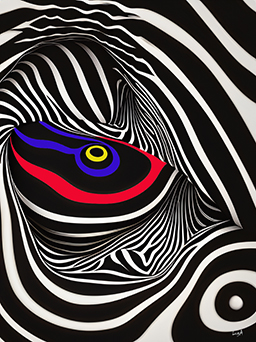 |
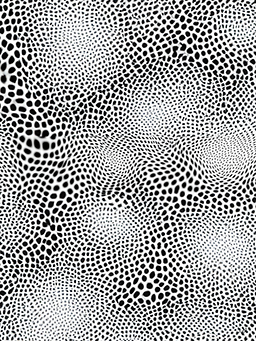 |
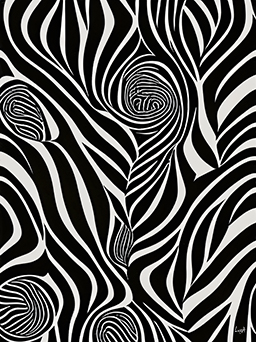 |
 |
|
Billeder genereret ved hjælp af KI/Image
generated by means of AI. |
|
 |
 |
 |
 |
Piet
Mondrian,
"Komposition med rød, blå, sort, gul og grå", 1921,
MoMA,
New York.
Piet
Mondrian,
"Composition with Red, Blue,
Black, Yellow, and Gray", 1921,
MoMA,
New York. |
|
 |
|
De Stijl
var en nederlandsk
kunstnersammenslutning, der blev stiftet i
Leiden i 1917 af
Theo van Doesburg og
Piet
Mondrian.
De Stijls stil er
neoplasticismen inspireret af
kubismen.
Neoplasticismens
udtryk er plangeometrisk
nonfigurativ,
forenklet abstrakt, bestående af
lige linjer og koloristisk af de tre
primærfarver (gul, rød, blå) samt sort og hvidt. |
 |
|
De Stijl
was a Dutch artist movement
founded in Leiden in 1917 by
Theo van Doesburg
and
Piet
Mondrian.
De Stijl's style was
Neoplasticism influenced by
Cubism. Neoplaticism is a non-figurative
plane geometrical simplified abstract art
consisting of straight lines and the three
primary colours (yellow, red, blue) and black
and white. |
 |
Fælles for de
Stijl, futurismen,
konstruktivismen og
Op art er
bevægelsesillusionen,
dynamikken og
elementer som lige
linjer, geometriske
former, sort og hvid
og klare farver.
Comon to de Stijl,
Futurism,
Constructivism and
Op Art
are the illusion of
motion, dynamics and
elements such as
straight lines,
geometrical forms,
black and white and
bright colours. |
|
|
|
|
 |
Giacomo
Balla,
"Dynamikken af en hund i snor"
(Dinamismo di un cane
al guinzaglio), 1912, Albright-Knox Art Gallery,
Buffalo, New York.
Giacomo
Balla,
"Dynamism of a Dog on a Leash" (Dinamismo di un cane
al guinzaglio),
1912,
Albright-Knox Art Gallery, Buffalo, New York. |
|
 |
Futurismen
var en kunstnerisk bevægelse i
Italien i perioden 1909-1918
grundlagt af den italienske
digter Filippo Tommaso Marinetti
der proklamerede: "Et brølende
automobil er smukkere end den
vingede sejrsgudinde" eller "En
bil i fuld fart er smukkere
end Nike fra Samotrake" og "Vi
vil forherlige krigen - verdens
eneste hygiejne...".
Futuristerne ville udtrykke
maskinalderens teknik,
effektivitet, fart og tempo - de
skildrede bevægelse i deres
billeder ved at gentage en form,
f.eks. kørende biler eller
gående mennesker. Det mest
berømte billede er Giacomo
Ballas "Dynamikken af en
hund i snor" fra 1912. |
 |
Futurism
was an artistic movement in
Italy between 1909-1918 founded
by the Italian poet Filippo
Tommaso Marinetti, who declared
"... a roaring car… is more
beautiful than The Victory of
Samothrace" and "We will glorify
war - the world's only hygiene".
Futurists tried to express the
energy and values of the machine
age - they expressed motion in
their paintings by repetition of
forms e.g. wheeled traffic or
walking people. The most famous
painting is "Dynamism of a Dog
on a Leash", 1912, by Giacomo
Balla. |
|
|
 |
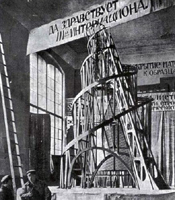 |
 |
Vladimir Tatlin
model af "Tatlins Tårn" eller "Monumentet for
3. Internationale".
Vladimir Tatlin
model of "Tatlin’s Tower" or "The Monument to
the Third International". |
|
 |
Konstruktivisme
er betegnelsen for en russisk
nonfigurativ
kunstretning og arkitektur, der
er samtidig med
Bauhaus Skolen i Weimar,
grundlagt i 1919 af
Walter
Gropius, og grundlaget for
funktionalismen. "Tatlins
Tårn" fra 1920 fremhæves
altid som det mest typiske
eksempel på konstruktivisme. Det
var en monumental bygning skabt
af den russiske kunstner og
arkitekt Vladimir Tatlin, men
blev aldrig opført. Den var
planlagt til opførelse i
Petrograd (nu Skt. Petersborg)
efter Revolutionen i 1917 som
hovedkvarter og monument for
Komintern (3. Internationale).
Konstruktivisterne skabte en
udtryksform, en collage, som
indeholdt en fjerde dimension,
nemlig bevægelse/tid ud over de
tre gængse dimensioner bredde,
højde og dybde.
 |
Constructivism
was an artistic and
architectural Russian movement
(1919-1934), non-figurative art
contemporary with the
Bauhaus School
i Weimar, founded in 1919 by
Walter
Gropius, in which a basis
for Functionalism was made.
Always mentioned as the most
typical architectural example of
Constructivism is "Tatlin's
Tower" from 1920. It was a
monumental building envisioned
by the Russian artist and
architect Vladimir Tatlin, but
never built. It was planned to
be erected in Petrograd (now St.
Petersburg) after the Bolshevik
Revolution of 1917, as the
headquarters and monument of the
Comintern (the Third
International). The
constructivist created a new
mode of expression, a collage,
containing a time/motion aka the
fourth dimension. |
|
|
|
 |
Kunstnere, også de antikke grækere og romere, har
altid skabt en illusion af den synlige virkelighed ved brug
af de grundlæggende geometriske principper. De gamle
teknikker blev genopdaget af renæssancemalerne, der
eksperimenterede med optisk illusion for at få en plan
flade til at fremtræde tredimensional. Den optiske illusion fortsattes af manieristerne, barokmalerne og så fremdeles.
Kunstnere som impressionisten
Claude
Monet, impressionisten
og pointillisten
Georges Seurat og postimpressionisten
Paul
Cézanne inspirerede Op Art kunstnerne. Nogle gange er impressionismen blevet betegnet
optisk realisme på grund af den næsten videnskabelige interesse i
optiske virkemidler og forsøget med lyset og dets effekter. Impressionisternes motto var "det menneskelige øje er et
utroligt instrument".
Op Art er et abstrakt
intellektuelt
og systematisk udtryk, der
gør brug af de geometriske former og udnytter de
optiske virkemidler, den fysiske og psykologiske
synsproces, og det medfører optisk bedrag og danner
billeder, som giver indtryk af en flade i evig bevægelse,
et dynamisk udtryk. Farverne bruges til at skabe visuelle
effekter så som efterbilleder eller trompe l'oeil.
Billeder og skulpturer skabt af sorte og hvide planer eller
kontrasterende farver synes at vibrere eller flimre.
I en artikel fra oktober 1964 i
Time
magazine med titlen "Op
Art: Pictures that attack the eye" blev Op Art
anvendt om billeder, der havde fokus på manipulation af
øjet. Ideen med Op Art var et poetisk spil med lys der forvirrede
øjet og ikke nogen visuel irritation. Det var hensigten
at kaste lys over det faktum at øjet kan snyde beskueren
til at se ting, der ikke er der, og hvis visuel illusion kan
snyde øjet så kan ord og propaganda også. Op Art tragtede efter at nedbryde barriererne mellem kunst
og teknologi så vel som at etablere forbindelse mellem
forskellige grene af videnskab så som optik (læren om
lysets natur og anvendelser) og kybernetik ("styringskunst").
Det betød en ny anvendelse af form og figur
inkluderende industriel æstetik. |
 |
Going
further back it is possible to see a natural progression
which lead to Modern Art movements, to Op Art. One can
say that artists, even the ancient Greeks and Romans,
created illusions of visual reality by using the basic
geometric principles. The ancient techniques was
rediscovered by the Renaissance painters who
experimented with optical illusions so a flat surface
could appear three-dimensional. The optical illusions
were continued by the Mannerist painters, the Baroque
painters and so on.
Artists such
as the Impressionist
Claude
Monet,
(1840-1926), the Impressionist and Pointillist
Georges Seurat
(1859-1891) and the Postimpressionist
Paul
Cézanne
(1839-1906) have
inspired the Op Artist with there theories of optics.
Sometimes Impressionism is called Optical Realism because
of its almost scientific interest in the actual visual
experience and effect of light, and movement on
appearance of objects. The Impressionist motto
was: "human eye is a marvelous instrument".
Optical Art is a method of painting,
it is abstract
art using geometrical forms to create an optical
illusion, it is dynamic
visual art.
Colours are used in creating visual effects, such as
afterimages and trompe l'oeil. Paintings and sculptures
created of black and white planes or contrasting colours
seem to move and vibrate.
Time
magazine gave in an article called
"Op
Art: Pictures that attack the eye"
published in October 1964, the
term "Op Art" to
paintings that focused on manipulation of the eye.
The
idea of Op Art was poetic play with light, to confuse
the eye, and not
visual irritations, and it was to highlight the fact
that the eyes can trick the mind in to seeing things
that are not there, and that if visual illusions can
trick the eye so can words and propaganda. Op Art strived to
break down the barriers between art and technology, as
well as to establish relationships between the various
branches of science, such as optics and cybernetics. It
embodies new uses of form and shape, including
industrial aesthetics.
|
|
 |
|
OP ART:
PICTURES THAT ATTACK THE EYE,
TIME THE WEEKLY NEWS MAGAZINE October
23, 1964 |
|
|
|
Op
Art indeholder alle ingredienserne til
en optometrists mareridt.
Op
Art contains all the ingredients of an
optometrist's nightmare. |
|
|
|
Optical
Art er dette års kjolelængde.
Optical
Art is this year's dress length. |
|
|
|
Op
Art fascinerer på samme måde som et kalejdoskop
fascinerer et barn.
Op
Art fascinates the way a kaleidoscope does
to a child. |
|
|
|
Dets
faldgrube er at fascinationen går over
til at være gentagelse og
kedsommelighed.
Its
pitfall is that
fascination often turns,
by repetition, to
boredom. |
|
|
|
Op
Art er fundamentalt et stillestående
optisk fænomen som trælbinder og
betager øjet.
Op
Art
are the essentially static visual
phenomena that enslave and enthrall the
eye. |
|
|
|
Vi anser os selv for
tekniske eksperter, i
middelalderlig forstand,
mere end kunstnere.
We
consider ourselves technicians, in the
medieval sense, rather than artists. |
|
|
|
Optik
er et redskab, som perspektiv var det
engang.
Optics
is a tool, as perspective once was. |
|
|
|
 |
Er Op Art synonym med Kinetisk kunst? ja og
nej.
Kinetisk kunst har rødder i russisk avantgarde,
og betegner kunst, der opererer med
bevægelse, virkelig eller
tilsyneladende.
En enkel forklaring er at både Op Art og Kinetisk kunst er
optaget af ideen om at skabe bevægelsesillusion på en plan
flade. Imidlertid er kinetisk kunst først og fremmest kunst som
indeholder bevægelige dele eller er afhængig at
bevægelse, f.eks. Alexander Calders mobiler som bevæges
enten ved luftstrømme eller
elektronisk eller magnetisk.
Kinetisk kunst stammer fra de russiske konstruktivister
herunder Naum Gabo (1890-1977),
der var pioneren inden for stilen. Også den
ungarske maler, fotograf og Bauhaus professor
László
Moholy-Nagy var inspireret af konstruktivismen og en
stor forkæmper for integration af teknologi og industri i
kunsten.
Fremkomsten af Op Art og kinetisk kunst i begyndelsen af
1960'erne viste en stor interesse for objektivitet og
videnskabelige eksperimenter. Fascineret af de fysiske love
for lyset har en hel generation af kunstnere udforsket visuelle fænomener og principper for
perception. |
 |
Is Op Art
synonymous with
Kinetic Art? The answer is Yes or No.
A simple
explanation is that both Op Art and Kinetic Art
concentrate on the idea of creating illusion of movement
on a flat plane.
Kinetic art is first and foremost art that contains
moving parts or depends on motion for its effect, e.g.
Alexander
Calder’s mobiles that are moved either by
air currents or by some artificial means - usually
electronic or magnetic.
Kinetic
Art originated
in Russia by Constructivists such as the Russian
sculptor Naum Gabo (1890-1977),
a pioneer of Kinetic Art. Also the Hungarian painter,
photographer and Bauhaus-professor
László
Moholy-Nagy
was
highly influenced by Constructivism and a strong
advocate of the integration of technology and industry
into the arts.
The emergence
of Op art and kinetic art in the early 1960s
evinced a
strong interest in objectivity and in scientific
experiment. Fascinated by the physical laws of
light and optics, a whole generation of artists
devoted themselves to explore visual phenomena
and principles of perception. |
 |
|
KUNSTNERE/ARTISTS |
 |
 |
|
Vasarely,
Victor |
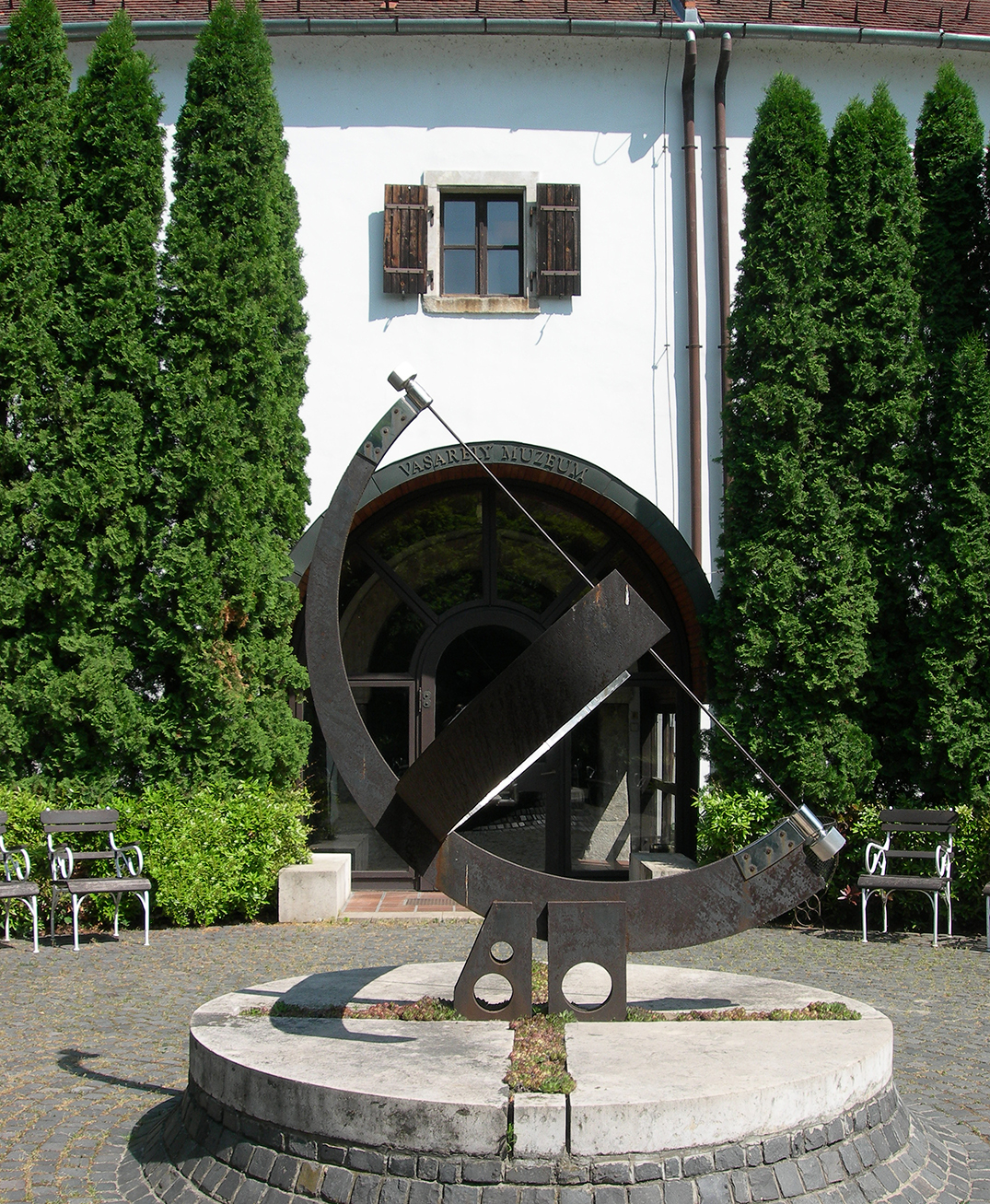 |
 |
|
Vasarely Múzeum,
Budapest. |
 |
Victor Vasarely
(Vásárhelyi Győző) (1906-1997).
Ungarsk-fransk kunstner. Op Art kunstens fader -
retningens ledende teoretiker og dens mest opfindsomme
praktiker. Vasarely blev født i Pécs i
Ungarn, han
døde i Paris. Fra 1925-27 studerede han ved
kunstakademiet i Budapest, og derefter studerede han
under Sándor Bortnyik på Mühely (Budapests
Bauhaus) - på Mühely fik Vasarely kendskab til
Klees
og Kandinskys
abstrakt-geometriske kunst samt Wilhelm Ostwalds
farvelære. Vasarely bosatte sig i Paris i begyndelsen af
1930'erne, og han giftede sig med Claire Spinner,
sammen fik de to sønner. I Paris arbejdede Vasarely
som grafiker, og udførte her sit første og det
første Op Art billede "Zebra",
bestående af buede sorte og hvide striber. De følgende år udforskede
han de optiske effekter i sine grafiske arbejder, og i løbet
af de næste to årtier udviklede Vasarely sin egen
naturvidenskabelige stil af geometrisk abstrakt kunst
- malerier, tegninger og konstruktioner i sort-hvid. I
1950'erne indførte han nye materialer i sine billeder
så som glas og aluminium. I 1955
publiserede han sit "Gule Manifest" (Manifeste
Jaune), han var klar over at staffelimaleriet var
umoderne og foreslog nødvendigheden af en ensartethed i den
plastiske kunst.
Da han opfandt Op Art i 1957, forestillede han sig, at kunsten fik en ny funktion, han
konkluderede at et kunstværk ikke er en refleksion af
en indre verden, men snarere er det en genstand, som er
resultatet af et arbejde, hvis eneste berettigelse er,
at det giver skønhed og glæde til mennesket og er
medvirkende til fred og harmoni. Billedet "Vega"
fra 1957 ligner et forvredet skakbræt, opkaldt efter
den klareste stjerne i stjernebilledet Lyren, et billede
i bevægelse.
I slutningen af 1960'erne havde han stor succes med Op
Art udstillingen "Lumière et mouvement" på
Musee d'Art Moderne i Paris. I 1970 indviede Vasarely sit eget museum Musee Vasarely
i Château de Gordes i Vaucluse i Sydfrankrig. Han modtog mange kunst- og
ærespriser bl.a. blev han
udnævnt til fransk æreslegionær og æresborger i New
York, han modtog
Guggenheim prisen, kunstkritikerprisen i Bruxelles og en
guldmedalje på Milano Triennalen.
En fransk astronaut medbragte 157 tryk af Vasarely om
bord i det Sovjetiske rumfartøj Salyut 7 i 1982. I 1987 blev Vasarely Museet i Budapest i Ungarn indviet,
museet ejer en stor samling af hans arbejder samt arbejder
af andre ungarske kunstnere, der arbejdede udenfor landet. |
 |
Victor Vasarely
(Vásárhelyi Győző) (1906-1997),
Hungarian artist,
the father of
Optical Art, the style's leading theorist and
its most inventive practician, a man of science who understood ahead
of everybody else how technology would radically change our world,
an intuition that he projected into his works. An artist and
socialist whose goal was to create designs that were universal, to
produce an art that could be mass produced and affordable for
everyone. A man who was fascinated with an art of pure visual
perception without traditional themes. A man whose
works are represented at major museum all over the world. A man who
received many artistic
awards and honorary awards, e.g. he was awarded the rank
of Officer in the French Legion of Honor and honorary citizen of New
York, he received the Guggenheim Prize and the Art Critics Prize in
Brussels, and he won a gold medal at the Milan Triennale.
Vasarely was
born in Pécs in 1906 and died in Paris
in 1997 at the age of 91.
He spent his childhood and teenage years living in Pöstyén
(now
Pieštany,
Slovakia) until his family moved to Budapest
in
1919. In
1925 after finishing secondary school he studied
medicine at the
University
of
Budapest.
Throughout his early life Vasarely found himself drawn more towards
the sciences than the arts. In 1927 he decided to change direction
completely. He abandoned medicine to learn traditional academic
painting in
Budapest, first at the private
Podolini-Volkmann
Academy, and in
1929 he enrolled at Alexander
Bortnyik's
Műhely Academy,
then widely
recognized as the center of
Bauhaus studies in Budapest.
Bortnyik followed the principles of the Bauhaus School of Dessau.
The German Bauhaus
(1919-1932) was the most important school of
architecture, art and design of the 20th century. Cooperation
between architects, painters, sculptors, designers and craftsmen -
an interplay between art and technology should create a harmonic
whole, and all sorts of applied art and artistic products should be
summarized into a common manifesto. Design could improve society,
not just be a reflection of society. Bauhaus' style was
characterized by economy of method, a strict geometry of form and
design that took into account the nature of the materials employed.
The Bauhaus thoughts had an enormous impact in
Vasarely’s work, leaving an indelible mark in his creation up until
the end. It was during this period that he initiated himself into
the tendencies of
Constructivism and discovered
Abstract Art. At Mühely he became acquainted with the abstract
geometric art of
Klee
and
Kandinsky
and Wilhelm Ostwald’s colour system.
These years studying medicine were far from wasted though as the
formal scientific training provided him with a strong sense of
scientific method and objectivity - something that stood him in good
stead throughout his artistic career.
In 1930 Vasarely settles in
Paris, where he worked as a graphic
artist for various advertising agencies, and he began his "Zebra"
studies. In the following years he explored optical effects in his
graphic works, and in the next two decades he developed his own
(scientific) abstract geometric style - paintings, drawings and
designs in black and white.
In 1931 he married Claire Spinner, who was also an
artist, she gave birth to their two sons André and
Jean-Pierre, the latter
became an artist
known as
Yvaral, he died in 2002, he also
worked in the fields of Op Art.
From the 1950's on, Vasarely insistently questioned
himself about the role of the artist in society and eagerly searched
for a way to create a social art, accessible and available to all.
In the 1950s he introduced
new materials in his
paintings e.g. glass and
aluminium, and completed
several architectural
integrations e.g.
the
ceramic wall from 1954 "Tribute to
Malevich"
at the University of Caracas, Venezuela -
(Integration of Art in the City). In 1955 he
published his "Manifeste jaune"
("Yellow Manifesto") - he was aware of
that the easel painting was outdated and
suggested the necessity of homogeneity in
plastic art. He imagined a new function of art,
he concluded that a work of art was not a
reflection of the inner world of the artist,
more like objects, a result of a work - the only
justification of art was to give beauty and joy
to human beings and to create peace and harmony.
During the 1960’s and 1970’s his optical
images became part of the popular culture,
having a deep impact on architecture, computer
science, fashion and the way we now look at
things in general. Even though he achieved great
fame he insisted on making his art accessible to
everyone. His motto was "Art for all".
In 1965, he
participated in the "Responsive
Eye" exhibition at
MoMA,
Museum of Modern Art,
New York, dedicated exclusively to "Optical
Art". It instituted a new relationship between
artist and spectator, where the observer cannot remain passive,
he is free to interpret the image in as many visual scenarios he
can conceive. Received with great acclaim, the press and the
public hailed Vasarely as the inventor and creator of "Op-Art".
In the late 1960s he achieved great success in the Op Art
exhibition "Lumière et mouvement" at Musée d'Art
Moderne in Paris.
1970 he inaugurated his own
Museum - Musée Vasarely in
Château de Gordes in Vaucluse
in the South of France. After his death in 1997 law of wills and
succession caused that his paintings were removed from the
museum.
In
1982 The French-Soviet team
of cosmonauts of the Salyut
7 transported into space 154
of Vasarely’s prints specially created
for such event. The prints were
later sold for the benefit of
UNESCO.
Vasarely remains one of the pillars
of contemporary art for having lead
abstract geometric painting into its
extraordinary culmination under the
name of Op Art or Kineticism. His
entire works are characterized by
great coherence, from the evolution
of his early graphic art to his
determination to promote a social
art.
In 1960 Vasarely said "The end of
personal art for a
sophisticated elite is near,
we are heading straight
towards a global
civilization, governed by
Sciences and Techniques. We
must integrate visual
sensibility into a correct
world" …
"The art of tomorrow will be
a common collective treasure
or it will not be art at
all".
In 1987
the
Vasarely
Museum
in
Budapest
was inaugurated, the museum houses a great
collection of his works and works by other
Hungarian artists, who worked outside the
country. |
|
 |
|
Victor Vasarely
- PERIODS |
|
|
|
Alexander
Bortnyik's Mühely Academy, Budapest
(1929-1930).
It
was during this period that Vasarely
initiated himself into the tendencies
of
Constructivism
and discovered
Abstract Art.
"Blue
Study",
1929. |
|
|
|
|
Early Graphic
Period
(1929-1946). Vasarely experimented with textural
effects, perspective, shadow and light.
"Zebra",
1938. |
|
|
|
Wrong Ways aka
Fausses Routes
(1935-1947). Vasarely was influenced by
Cubism and
Surrealism. He focused on still lives,
landscapes and portraits.
"Model",
1946. |
|
|
|
Belle-Isle
Period
(1947-1958). A
turning point in Vasarely's career - a
transformation of natural elements into
abstract art, a return to nature by
using geometrical forms such as the oval
which symbolizes the
oceanic feeling.
"Siliceous
Stone". |
|
|
|
Denfert Period
(1951-1958).
Primarily paintings influenced by the
walls at the Denfert-Rochereau metro
station located near Arcueil, where
Vasarely lived for more than 30 years.
"Chillan", 1952. |
|
|
|
Cristal-Gordes
Period
(1948-1958). "Homage à Malewitsch"
marks the turn towards kineticism.
The
Russian artist
Kasimir Malewitsch/Malevich
was one of the pioneers of Abstract Art,
the founder of
Suprematism, a style
using only a few colours and few basic
geometric shapes. By using strict,
simple shapes and colours, Malevich
could go beyond superficial appearances
to attain a deeper level of meaning. In
1913 he painted the epoch-making
"Black Square" a black square
on a ground of white.
"Homage
à Malewitsch",
1952-1958. |
|
|
|
Mixed Compositions.
"Pensar
5", 1956-68
(Pensar Spanish verb, to think). |
|
|
|
|
Black-White
Period
(1950-1965).
In this period he
developed the basic elements of Op-Art.
"Vega",
1957,
looks like a twisted chessboard, named
after the brightest star in the
constellation Lyra. |
|
|
|
Planetary
Folklore
(From 1960). Brightly coloured shapes which led to
the invention of his fine arts alphabet
"Alphabet Plastique", a
comprehensive "alphabet", a
universal fine arts language to be
understood by everyone, a step towards
truly collective art.
"Alom",
1966. |
|
|
|
Hommage à L´Hexagone
(1964-1976). Vasarely was attracted by cellular
structure in a series of works belonging
to "Homage to the hexagon"
theme.
"Tridim
C", 1968. |
|
|
|
Vonal
Period
(1964-1970).
In the "Vonal" series, he revisited his
earlier line studies (e.g. the Zebres
series) and graphic works but this time
making full use of colour.
"Boygo
I", 1969. |
|
|
|
Expansive-Regressive
Structures
(From 1968 onwards).
"Vega
Nor", 1969, shows the
warmth of Vasarely's colours and the
freshness.
From his "Vega Period". |
|
|
|
 |
|
Calder,
Alexander |
 |
Calder,
Alexander (1898-1976). Amerikansk-fransk kinetisk kunstner. Calder
er mest kendt for sine nonfigurative bevægelige monumentale
kompositioner, mobiler samt
figurer og portrætter af snoet metaltråd. Han er
født nær Philadelphia i en kendt kunstnerisk familie. Hans
far og bedstefar, der begge hed Alexander Calder, var
skulptører og hans mor portrætkunstner.
Calder er uddannet som maskiningeniør og senere som
kunstner i New York City fra 1923-26, hvor han studere
maleri hos bl.a. John Sloan og George Luks. I 1927 rejste
Calder til Paris. I begyndelsen skabte han små bevægelige træ- og
metaltrådsfigurer, som han samlede til et miniaturecirkus
med balancerende akrobater og brølende løver.
Populariteten med "Cirkus Calder" bragte ham i
kontakt med andre kunstneriske fornyere. Først i 1930'erne,
inspireret af farver og kompositioner i
Piet
Mondrians
arbejder, skabte Calder sine skelsættende mobiler. Først
var disse abstrakte skulpturer med motorer, senere skabte
han mobiler der bevægede sig med vinden. I 1933 rejste
Calder tilbage til USA, hvor hans abstrakt-organiske
skulpturer både mobiler og stillestående, stabiler, vakte
stor opsigt og anerkendelse. Efter 1950 tilbragte Calder
noget af året i Frankrig. Han udstillede på Louisiana i 1969. |
 |
|
Calder,
Alexander
(1898-1976). American-French Kinetic artist. He was born in
Lawton, Pennsylvania into a well-known family of artists.
His father and grandfather, were also Alexander Calder, both
sculptors, and his mother was a portrait artist. Calder
received an engineering degree. From 1923-25 he attended the
Art Students League in New York, studying briefly with
Thomas Hart Benton and John Sloan. His first exhibition of
paintings took place in 1926 at the Artist's Gallery in
New York. Later that year he went to Paris. He created small
movable figures made of wood and metal, which he
gathered into a miniature-circus with acrobats and roaring
lions. His popularity with "Circus Calder" established contact with the Paris avant-garde. In the 1930s,
influenced by the work of
Piet
Mondrian, he
executed his epoch-making mobiles. At first his abstract
sculptures were provided with engines, later his
mobiles moved simply by the wind. His moving sculptures were
called mobiles, the stationary stabiles.
In 1933 Calder returned to the US, where his abstract-organic sculptures (mobiles and
stabiles) attracted attention. He exhibited with the
Abstraction-Création group in Paris
in
1933. In
1943, the
Museum
of
Modern Art, New York, gave him a solo exhibition. Every year since 1950 he spent
several month in France. |
|
 |
|
Udvalgte
værker/Selected works |
|
"Genstand med røde
runde skiver", 1931,
Whitney Museum of American Art, New York.
"Object with Red
Discs, 1931,
Whitney Museum of American Art, New York. |
|
"Rød skive -
hvide prikker",
1960,
Peggy
Guggenheim
Samlingen,
Venedig/"Red
Disc - White
Dots",
1960,
Guggenheim
Collection, Venice. |
"Le
Guichet", (Billetkontoret),
1963,
foran
New York Library for the Performing
Arts, Lincoln Center Plaza.
"Le
Guichet",
(The Box Office), 1963, placed in
front of the New York Library for the
Performing Arts, Lincoln Center Plaza,
New York. |
|
"Hoveder
og hale" (Têtes
et Queue), 1965, Neue Nationalgalerie,
Berlin/"Heads
and Tail" (Têtes et Queue),
1965,
Neue Nationalgalerie,
Berlin. |
|
"Carmen", 1974, Museo
Reina
Sofía, Madrid. |
|
"Uden titel", 1976,
National Gallery
of Art, East Building, Washington D.C./"Untitled", 1976,
National Gallery
of Art, East Building, Washington D.C. |
|
|
 |
Jean
Tinguely & Niki de Saint Phalle
Kunstens Bonnie og
Clyde/The Bonnie and
Clyde of Art |
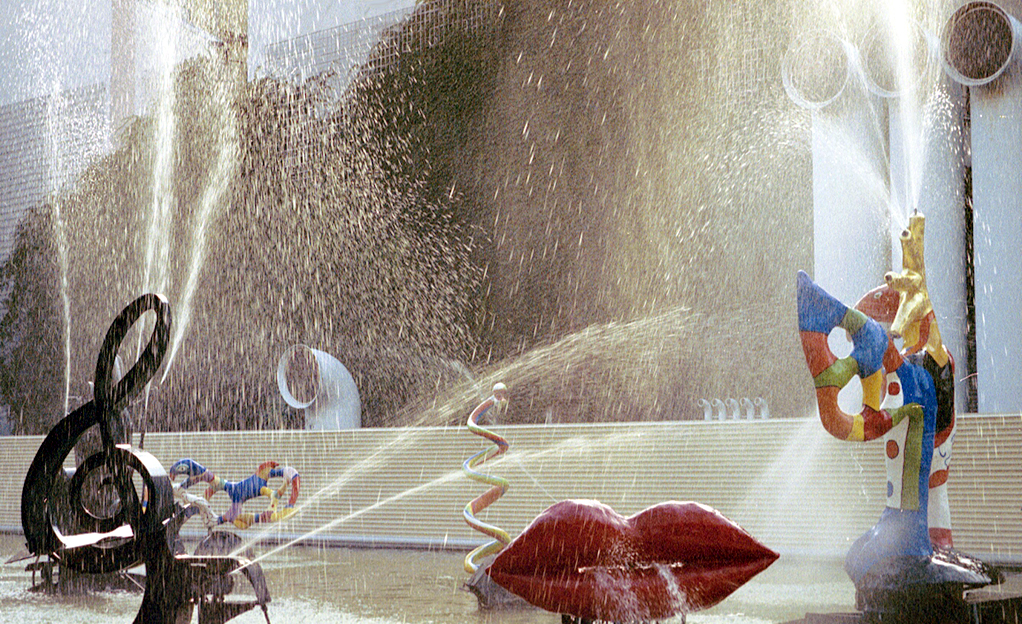 |
 |
Stravinsky springvandet
med 16 skulpturer, der
bevæger sig og springer med
vand, repræsenterende værker
af komponisten Igor
Stravinsky. Udført i 1983 af
Tinguely og Niki
de Saint Phalle, Place
Stravinsky ved
Pompidoucentret i Paris.
The Stravinsky Fountain
with 16 sculptures moving
and spraying water,
representing the works of
the composer Igor
Stravinsky. Executed in 1983
by Tinguely and
Niki de Saint Phalle,
Place Stravinsky next to
Centre Georges-Pompidou in
Paris. |
 |
Tinguely, Jean
(1925-1991).
Schweizisk kunstner uddannet i Basel og inspireret af
dadaisten
Kurt Schwitters. Hans første
soloudstilling var i 1954 i Paris. Tinguely er kendt for kinetiske
arbejder med maskinlignende objekter. Han anvendte gamle
hjul og andre genbrugsting, og hans arbejder kan betegnes
"junk art". Tinguely var gift med Niki de
Saint Phalle. Jean Tinguely Museet i Basel
åbnede i 1996. |
 |
|
|
|
 |
Saint Phalle, Niki de
-
en autodidakt outsider/A
self-taught outsider
(1930-2002). Fransk skulptør, maler
og instruktør, gift med med Jean Tinguely. I
begyndelsen af 1960'erne fremstillede Saint
Phalle "skydebilleder". Hun anbragte
plastikposer med maling bag billeder og
skulpturer. Poserne gik itu når der blev
skudt på værkerne med et gevær af hende
eller andre deltagere.
Et af hendes mest berømte arbejder er
"Hun - en katedral", 1966, Moderna
Museet, Stockholm. En gigantisk kvindefigur,
en slags moder jord, 28 m lang og udført i
Saint Phalles karakteristiske "Nana stil".
Beskueren kan gå ind i skulpturen. Saint
Phalles "Nana stil" var farverige frodige
kvinder (nanas er slang for piger). I
Fribourg i Schweiz kan ses værker af Saint Phalle og
Tinguely på "Espace Jean Tinguely - Niki de
Saint Phalle".
Jean Tinguely og Niki de Saint Phalle kaldte
sig selv for "Kunstens Bonnie og Clyde".
Saint Phalle, Niki de (1930-2002).
French sculptur, painter and filmmaker, married to Jean Tinguely. In the early 1960s
she created "Shooting Paintings". She placed
plastic bags filled with paint behind
paintings and sculptures, the bags burst
when the works were shot by a gun held by
her or other participants.
One of her most famous works is "She - a
Cathedral", 1966, Moderna Museet,
Stockholm. A gigantic female figure, a earth
mother, 28 meters long, carried out in Saint
Phalle's characteristic Nana style. Nana is
slang for girl. Works of Saint Phalle and
Tinguely can be seen at "Espace Jean
Tinguely - Niki de Saint Phalle" in
Fribourg in Switzerland.
Jean Tinguely and Niki de Saint Phalle
called themselves "The Bonnie and Clyde of
Art". |
 |
|
|
Udvalgte
værker/Selected works |
|
"Nana Baloon (eller Store Nana i bevægelse)", 1960'erne, Statens Museum for Kunst.
"Nana Baloon (or Big Nana in Motion)", 1960s,
National Gallery of Denmark, Copenhagen. |
"Skydebillede Den
Amerikanske Ambassade", 1961,
MoMA,
Museum of Modern Art,
New York.
"Shooting
Painting American Embassy", 1961,
MoMA,
Museum of Modern Art,
New York. |
|
"Nana",
1974, Hannover, Tyskland/"Nana", 1974, Hannover, Germany. |
|
"Skytsenglen",
1997, Hovedbanegården i Zürich/"The Guardian Angel ", 1997, The Zurich Main Station. |
|
|
 |
|
Agam,
Yaacov |
 |
|
Agam,
Yaacov
(1928). Israelsk maler og billedhugger, den førende eksponent for optisk og kinetisk
kunst, bedst
kendt for sine tredimensionale billeder og skulpturer. Agam var søn af
en russisk rettroende rabbiner og forfatter. Som
barn begyndte han at tegne til trods for religiøs forbud mod
billedudtryk. Hans familie anerkendte kan kunstneriske evner,
og i 1946 begyndte han på "Bezalel Academy of Arts and
Design" i Jerusalem. Studier hos Mordecai Ardom, en
tidligere elev i Bauhaus i Weimar. I 1950 kom Agam til Zurich
og studerede hos
Johannes Itten
på kunsthåndværkerskolen,
hvor han mødte
Frank Lloyd Wright
og Siegfried Giedion, og
deres ideer om tidsdimensionen i kunst og arkitektur gjorde
indtryk på ham. I 1951 flyttede Agam til Paris, hvor
surrealisterne opdagede og beundrede ham. Hans første
udstilling i "Galeri Craven" i Paris i 1953 viste
kinetisk kunst og blev en kritikersucces.
Max Ernst
var den
første, der købte et arbejde af Agam. |
 |
|
Agam,
Yaacov
(1928). Israeli Painter and Sculptor, son of a
Russian rabbi and author. Although
his religion was against drawing and painting,
he was not forbidden to do so by his
family, who acknowledged his talent.
In 1946 he became a student at "Bezalel
Academy of Arts and Design" in Jerusalem.
In 1950 he went to Zurich and became a student
of
Johannes Itten
at the
"Art and Craft School", where he met
Frank Lloyd Wright and Siegfried Giedion, whose
ideas about the time-dimension in art and
architecture impressed him. In
1951 he went to Paris, where his
works were admired by the
Surrealist artists. His first exhibition in
"Galerie Craven" in Paris in 1953
shows kinetic art and became a success. Max Ernst
was the first to buy one of
his works. Agam became the leading exponent of optical and
kinetic art, and is best known for his three-dimensional
paintings and sculptures. |
|
 |
|
Udvalgte
værker/Selected works |
|
|
"Synthesis: Solfage
Fusion", Serigraph from "Fusion suite", 1978. |
|
Springvand, 2005,
Dizengoff Square, Tel Aviv/Fountain,
2005, Dizengoff Square, Tel Aviv. |
|
Springvand, La Défense,
Paris/Fountain,
La Défense, Paris. |
|
|
 |
|
ØVRIGE KUNSTNERE/OTHER
ARTISTS |
|
|
Graevenitz, Gerhard von
(1934-1983) |
|
Tysk kunstner/German
artist.
"Kinetisk genstand: 37 hvide runde skiver på hvid
baggrund", 1967, Neue Nationalgalerie,
Berlin.
"Kinetic Object: 37 White Disks on White", 1967, Neue Nationalgalerie,
Berlin. |
|
|
Sýkora, Zdeněk
(1920-2011) |
|
Tjekkoslovakisk moderne abstrakt maler og skulptør og foregangsmand i anvendelsen af computergenereret kunst.
Czechoslovakian modern abstract painter and sculptor, and a pioneer in computer-generated art.
"Komposition", 1966, Neue Nationalgalerie,
Berlin.
"Composition", 1966, Neue Nationalgalerie,
Berlin. |
|
|
|
Engelsk kunstner/English artist.
"Flygtende centrum", 1962, Neue
Nationalgalerie,
Berlin.
"Escaping
Centre", 1962, Neue
Nationalgalerie,
Berlin.
"Blaze 1", 1962. |
|
|
|
Tysk kunstner/German artist.
"Stålskulptur", 1956, Neue Nationalgalerie,
Berlin.
"Steel Sculpture", 1956, Neue Nationalgalerie,
Berlin.
"Lille karrusel", 1958, Neue Nationalgalerie, Berlin.
"Small Merrry-Go-Round", 1958, Neue Nationalgalerie, Berlin. |
|
|
Escher,
Maurits
Cornelis
(1898-1972) |
|
Nederlandsk
kunster/Dutch graphic artist.
Udsnit af "Udsigtstårn", 1958.
Detail of
"Belvedere", 1958. |
|
|
|
Tysk-amerikansk kunstner/German-American artists.
"Helligdom",
1942,
fra serien Grafisk Tektonisk.
"Sanctuary",
1942, from the series Graphic
Tectonic.
"Hyldest til kvadratet", 1949,
(serie af billeder), Bottrop Museum,
Tyskland.
"Homage to the square", 1949, Bottrop
Museum, Germany.
"Homage to the Square: Soft Spoken",
1969. |
|
|
Stanczak, Julian
(1928-2017) |
|
Polsk-amerikansk kunstner/Polish-American
artist.
"Forbipasserende
kontur", 1960'erne.
"Passing
Contour", 1960s. |
|
|
Mavignier, Almir
de Silva
(1925-2018) |
|
|
Brasiliansk kunstner/Brazilian
artist.
"To kvadrater", 1967.
"Two Squares", 1967. |
|
|
|
|
Amerikansk kunstner/American artist.
"Dyb
magentarød kvadrat", 1978.
"Deep
Magenta Square", 1978. |
|
|
|
|
|
|

